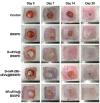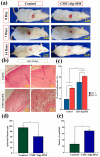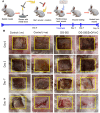Advanced biomaterial strategies for overcoming age-associated wound healing impairments
- PMID: 40488106
- PMCID: PMC12145203
- DOI: 10.1063/5.0251889
Advanced biomaterial strategies for overcoming age-associated wound healing impairments
Abstract
Dermal wounds represent a substantial global healthcare burden, with significant economic impact and reduced quality of life for affected individuals. As skin ages, the wound healing capacity is significantly diminished through multiple pathways, including reduced cellular proliferation, altered inflammatory responses, impaired vascularization, and decreased extracellular matrix production. With worldwide demographics shifting toward an older population, effective wound management has become an increasingly critical healthcare challenge. Biomaterials have emerged as a powerful tool to address the specific challenges of wound healing by providing structural support and delivering therapeutic agents to facilitate tissue regeneration. These materials can even be engineered to match the specific mechanical properties of aged tissue while simultaneously releasing key age-tailored bioactive molecules, thereby addressing the complex healing deficits in aged skin. Recent advances in aged skin models have established them as crucial platforms for translational research, enabling more accurate prediction of biomaterial performance in elderly patients. Concurrently, composite biomaterials, which combine multiple functionalities in a single platform, have gained prominence as particularly promising clinical solutions. Though significant progress has been made, challenges persist in optimizing material properties and achieving reproducible clinical outcomes, demanding continued research focused specifically on age-related wound healing impairments.
© 2025 Author(s).
Conflict of interest statement
The authors have no conflicts to disclose.
Figures











Similar articles
-
Advances in Designer Materials for Chronic Wound Healing.Adv Wound Care (New Rochelle). 2025 Apr 30. doi: 10.1089/wound.2024.0108. Online ahead of print. Adv Wound Care (New Rochelle). 2025. PMID: 40306934 Review.
-
Engineered Biopolymeric Scaffolds for Chronic Wound Healing.Front Physiol. 2016 Aug 5;7:341. doi: 10.3389/fphys.2016.00341. eCollection 2016. Front Physiol. 2016. PMID: 27547189 Free PMC article. Review.
-
Injectable self-assembling peptide nanofiber hydrogel as a bioactive 3D platform to promote chronic wound tissue regeneration.Acta Biomater. 2021 Nov;135:100-112. doi: 10.1016/j.actbio.2021.08.008. Epub 2021 Aug 10. Acta Biomater. 2021. PMID: 34389483
-
Current Paradigms and Future Challenges in Harnessing Nanocellulose for Advanced Applications in Tissue Engineering: A Critical State-of-the-Art Review for Biomedicine.Int J Mol Sci. 2025 Feb 9;26(4):1449. doi: 10.3390/ijms26041449. Int J Mol Sci. 2025. PMID: 40003914 Free PMC article. Review.
-
Tissue Engineered Skin and Wound Healing: Current Strategies and Future Directions.Curr Pharm Des. 2017;23(24):3455-3482. doi: 10.2174/1381612823666170526094606. Curr Pharm Des. 2017. PMID: 28552069 Review.
References
-
- Sen C. K., Gordillo G. M., Roy S., Kirsner R., Lambert L., Hunt T. K., Gottrup F., Gurtner G. C., and Longaker M. T., “Human skin wounds: A major and snowballing threat to public health and the economy,” Wound Repair Regener. 17(6), 763–771 (2009).10.1111/j.1524-475X.2009.00543.x - DOI - PMC - PubMed
-
- Posnett and P. J. Franks J., “The burden of chronic wounds in the UK,” Nurs. Times 104(3), 44–45 (2008). - PubMed
Publication types
LinkOut - more resources
Full Text Sources
Research Materials

